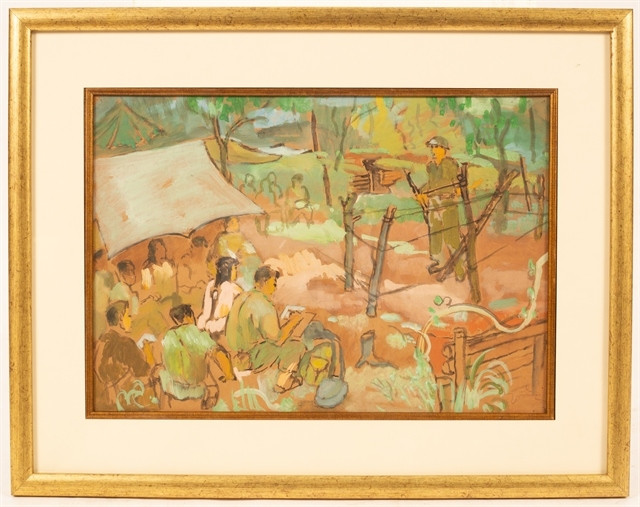

While the subject of war is at the forefront of everybody’s minds, Tam expressed his inner conflicts about fighting and the feelings around it, through art.
He sought to capture the realism and atrocities of his personal experience of war, alongside the humanity and everyday life within it.
Commenting on the collection, the current owner said, “As a long-term expat in Saigon I was fascinated in the history and art of the country and started collecting Vietnamese art. I was captivated by Tam’s rapid fluidity of sketching in the most adverse conditions, and how it caught that moment in time.”
Born into a revolutionary family, Tam adopted the country's freedom and independence cause as a teenager, when he joined up for the August 1945 Revolution launched by the Viet Minh (the League for the Independence of Vietnam) to overthrow the Japanese fascists and French colonialists.
During the first Indochina War (1946-54), Tam joined the publicity and information division of the resistance force against the French, which was his first exposure to using art to express feeling.
The division exhibited three times up until 1948, when Tam attended a six-month painting course in the jungle. Here he created wall paintings celebrating the resistance movement, aimed at intimidating French military units based nearby. This led to his appointment to the Information Office in Hung Yen Province to draw posters, and would begin a lifelong passion for art.
In 1950 he joined the Vietnam People's Army where he served not just as a soldier but as a war reporter and artist, working for the Quyet Thang newspaper.
In 1954 Tam participated in the battle of Đien Bien Phu. Living on the front line he wrote reports and drew sketches of what he saw. The drawings won him third place in the National Art Exhibition in Hanoi a year later when the resistance government took over the city from the French.
He had further study at the Vietnam Fine Arts College in Hanoi, and continued to work as an artist and war corespondent for the Hình Ảnh Quân Đội (Military Images) magazine, Văn Nghệ Quân Đội (Military Literature and Art) magazine, and Quân Đội Nhân Dân (the People's Army) newspaper.
During the anti-American war, he went to the southern battlefields. He wrote and painted along the Ho Chi Minh Trail, in Khe Sanh, Quang Tri, Da Nang and during the Sai Gon liberation campaign.
While working under very difficult circumstances Tâm was able to save the majority of his paintings and sketches by sending them back to Hanoi for safe keeping.
He recalled (to Sherry Buchanan of The Guardian, at Khe Sanh), “I did the watercolours right there at the battle, I used a plume rehaussée d'aquarelle (pen with watercolour). The idea was not to hang around too long in one place, so I would usually add the pen later on. When I travelled around the country and there was no fierce fighting, I had more time to sketch carefully. I travelled with a photographer. That was very useful. When I forgot details, I could look at his pictures and fill them in. I used all kinds of materials: watercolour, pen, pencil – whatever I could find.”
Tam was a founding member of the Vietnam Fine Arts Association in 1957 and was later recognised for his exceptional contribution to Vietnamese art, by being appointed the Director of the Military Fine Arts Workshop (later merged into the Military Museum) in 1978.
While in this post he held art exhibitions and taught fine arts. In 1989, having retired from the army at the rank of Colonel, he moved to Ho Chi Minh City, devoting his time to creating images reminiscent of his life during the resistance wars from his frontline sketches, using his signature materials: oils, silk, watercolour, pencil and pen.
His diary entries from the latter part of his life and an array of sketches were collated in the book Drawing Under Fire: War Diary of a Young Vietnamese Artist, published in 2005. He is considered one of the most ìnfluential Vietnamese artists of his time.
Commenting on the series of eight drawings being offered at auction, Chorley’s director Werner Freundel said, “Tam’s impressionistic artworks, drawn from life in the battlefield and Vietnamese camps, capture the realities of war and intimate snapshots of daily life on the battlefield. They are hardly ever seen at auction, making these exceptionally rare.”
Among the highlights in the series are the Study of a Young Female Soldier in pen and ink, Soldiers Embarking on a Boat in pen and ink, Villagers and Soldier in a Landscape in watercolour, Figures Sitting Around a Pot in pen and ink, Saigon, Army Tank #2 in pen and ink, Days Following the Footsteps of the Enemy in watercolour over traces of pencil on paper, and Barracks Scene in pencil on paper.
Source: VOV